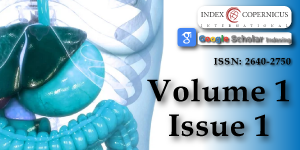Role of Accessory Right Inferior Hepatic Veins in evaluation of Liver Transplantation
Main Article Content
Abstract
Purpose: The purpose of the study is to access the prevalence of accessory right inferior hepatic veins and their relevant significance in liver transplantation.
Materials and Methods: A retrospective study was done in which the CT of 82 potential liver transplant candidates between January 2012 and March 2013 were reviewed. The presence of the accessory right inferior hepatic vein was examined; the diameters of the accessory inferior hepatic veins and the distance between the point where they open into the inferior vena cava on the coronal plane and to the right hepatic vein-inferior vena cava junction was measured.
Results: Out of 82 patients, 42 (51%) had accessory right inferior hepatic veins. Right accessory inferior hepatic veins larger than 3 mm were detected in 23 (28%) patients. The distance of these veins to the right hepatic vein-inferior vena cava junction was more than 4 cm in 13 (15%) patients.
Conclusion: The precise preoperative knowledge of accessory right inferior hepatic veins is essential in living donor liver transplantation.
Article Details
Copyright (c) 2017 Ahmed A, et al.

This work is licensed under a Creative Commons Attribution 4.0 International License.
Ajay K. Singh, Arun C. Nachiappan, Hetal A. Verma, Raul N. Uppot, Michael A. Blake, et al. Postoperative Imaging in Liver Transplantation: What Radiologists Should Know. Radiographics. 2010; 30: 339-351. Ref.: https://goo.gl/iFhFZ6
Juan C. Camacho, Courtney Coursey-Moreno, Juan C. Telleria, Diego A. Aguirre, William E. Torres, et al. Nonvascular Post-Liver Transplantation Complications: From US Screening to Crosssectional and Interventional Imaging. Radiographics. 2015; 35: 87-104. Ref.: https://goo.gl/tQ7gMK
Ioannou GN. Development and validation of a model predicting graft survival after liver transplantation. Liver Transpl. 2006; 12: 1594-1606. Ref.: https://goo.gl/FDd1FE
Lewis D. Hahn, Sukru H. Emre, Gary M. Israel. Radiographic features of Potential Liver Donors that Precluded Donation. American Journal of Roentgenology. 2014; 202: W343-W348.
Ana Alonso-Torres, Jaime Fernández-Cuadrado, Inmaculada Pinilla, Manuel Parrón, Emilio de Vicente, et al. Multidetector CT in the Evaluation of Potential Living Donors for Liver Transplantation. Radiographics. 2005; 25. Ref.: https://goo.gl/5DNcbf
Sahani D, Mehta A, Blake M, Prasad S, Harris G, et al. Preoperative Hepatic Vascular Evaluation with CT and MR Angiography: Implications for Surgery. Ridographics. 2004; 24: 1367-1380. Ref.: https://goo.gl/g45FXW
TsangLL, ChenCL, HuangTL, T.-Y.Chen, C.-C.Wang, et al. Preoperative imaging evaluation of potential living liver donors: reasons for exclusion from donation in adult living donor liver transplantation. Transplant Proc. 2008; 40: 2460-2462. Ref.: https://goo.gl/htVi6R
SahaniD, MehtaA, BlakeM, PrasadS, HarrisG, SainiS. Preoperative hepatic vascular evaluation with CT and MR angiography: implications for surgery. RadioGraphics.2004; 24:1367-1380. Ref.: https://goo.gl/g45FXW
CoveyAM, BrodyLA, GetrajdmanGI, SofocleousCT, BrownKT. Incidence, patterns, and clinical relevance of variant portal vein anatomy. AJR Am J Roentgenol. 2004; 183: 1055-1064. Ref.: https://goo.gl/S3XkEH
Onofrio A. Catalano, Anandkumar H. Singh , Raul N. Uppot, Peter F. Hahn, Cristina R. Ferrone, et al. Vascular and Biliary Variants in the Liver: Implications for Liver Surgery. Radiographics. 2008; 28: 359-378. Ref.: https://goo.gl/kdQHbJ
Radtke A, Sotiropoulos GC, Molmenti EP, Nadalinl S, Schroeder T, et al. The influence of accessory right inferior hepatic veins on the venous drainage in right graft living donor liver transplantation. Hepatogastroenterology. 2006; 53: 479-483. Ref.: https://goo.gl/xgaufq
Kalayci TO, Katlu R, Karasu S, Yilmaz S. Investigation of right lobe hepatic vein variations of donor using 64-detector computed tomography before living donor liver transplantation. Turk J Gastroenterol. 2014; 25: 9-14. Ref.: https://goo.gl/6bXMnf
Erbay N, Raptopoulos V, Pomfret EA, Kamel IR, Kruskal JB. Living donor liver transplantation in adults: vascular variants important in surgical planning for donors and recipients. AJR Am J Roentgenol. 2003; 181: 109-114. Ref.: https://goo.gl/pboVge
Amaedo M, John MH, Robert AF, Ann TO, Marc PP. Surgical Management of Anatomical Variations of the Right Lobe in Living Donor Liver Transplantation. Ann Surg. 2000; 231: 824-831. Ref.: https://goo.gl/SSj3pc
Parrilla P, Sanchez-Bueno F, Figueras J, Jaurrieta E, Mir J, et al. Analysis of the complications of the piggyback technique in 1112 liver transplants. Transplant Proc. 1999; 67: 1214-1217. Ref.: https://goo.gl/2L3UxF

